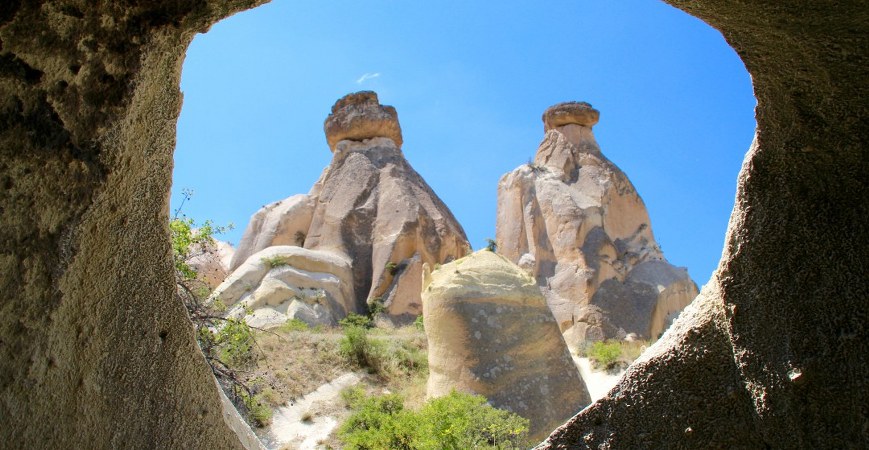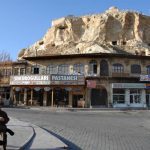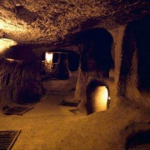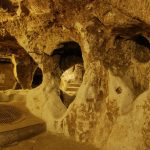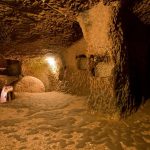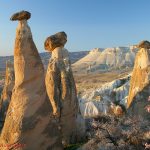Around Urgup Town in Cappadocia Turkey,
Saruhan (Caravanserai)
It was built as caravan serai on the highway of Konya, Aksaray and Kayseri by Se!auks (1238) (It is 10 km. far from Urgup on the Avanos road).
Library Of Tahsin Aga
It is a 19th-century building located on the Temenni Hill. It is the first library of the town established with the donation from a rich man named Tahsin Today Urgup has a large and rich library with many branches. Books are carried to the farthest villages by means of donkeys. The retired director, Mustafa Guzelgoz, was awarded a prize by the World Peace Corps Association for being the first man to establish a traveling library with donkeys.
The Underground Tunnel
It is 200 meters long, beginning from the Temenni Hill. The rooms on both sides are closable with large round stones in case of a danger.
Other Churches Around Urgup
There are various single or grouped monasteries in the Origin area. The frescoes of the Cambazli Church in Ortahisar are in a condition. Towards the north, inside the vineyards, the Chapel of Nicetas is also well protected. Here, it is possible to see the art of the Middle Ages. At some distance, in Meskendir Deresi, you can see the church of Paul and Peter. In the very old church of St. Theodora the paintings are wonderful. A domed church of 11th century is also interesting. In the Ortahisar basin, in Balkan DereS1, there is a group of four churches. The frescoes of the first are the oldest in Cappadocia (beginning of 6th century). There are important churches in Uzengi Dere, too (1 km. to Ortahisar). The church of the Holy Apostles in Sinasos, was painted during the reign of Constantine (913 – 920) by those who painted the Tokali Church. Also in the same village, the Church of the Precious Cross is full of wonderful paintings of Christ. In the village of Ayvali, together with linear decorated churches, the frescoes of the Ortamahalle and Karacali churches are worth seeing. During the 19th century, a lot of Greeks were living in Sinasos and there aren’t any old churches left in this village. Although, towards the middle of the town, there is an unfinished church of the 10th century. In the valley of Golgoli, there are some de-stroyed churches with their decayed frescoes. In Cemil, 10 km. to Sinasos, in a small valley, near a sacred fountain you can see the Monastery of the Archangel. Again in the same valley the Church of St. Stephen (7th and 8th centuries) is in a bad condition except for the cross on the ceiling. Next, to it, there is a large church with frescoes of the 11th century which remained well-preserved under a thick layer of soot. The village of Damsa is interesting with. It’s Islamic monuments. The double church in the village was dedicated to the 40 Martyrs who were much venerated in this area (1216 – 1217). During the 10th century a bishopric was established in Damsa for a short period of time. The settlement centres near Orta-keiy, Mavrucan and SoOanli provide good evidence for an active monastic life. In the destroyed church of Karlik and the Gothic church of Yesiloz it is possible to see the beautiful decorations of the 11th century.
Maccan (Avcilar)
Also known as Matiana, the Avcilar village, together with G6reme is one the two places with an Early Christian Age name. There are five churches around the village. The Durmu Church, dating 6th or 7th cen-tury, is undestroyed with its altar and eng-raved columns. The unworn appearence of the rocks gives the feeling that it was not used much. Probably the village was aban-doned during the Arab raids. The rock fall on the northern side is recent. The other churches are of 10th or 11th century. The most recent one is the Church of Yusuf Koa. The churches of Ortamahalle and Bezirhane are inside the village. The Karabulut Church is also worth seeing (40 minutes on foot)

